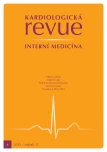Adults with congenital heart diseases
Authors:
J. Rubáčková-Popelová
Authors‘ workplace:
Centrum pro dospělé s vrozenou srdeční vadou, Kardiochirurgické oddělení, Nemocnice Na Homolce, Praha
Published in:
Kardiol Rev Int Med 2015, 17(4): 315-321
Category:
Cardiology Review
Overview
The number of adults with congenital heart diseases (CHD) has recently been estimated at 2,800–3,000 per one million inhabitants and has been constantly increasing. Approximately one half of the adults with CHD suffer from complex lesions requiring follow-up in specialised centres where there is sufficient knowledge of CHD among general cardiologists, internists and general practitioners. Many adults treated for CHD in childhood require further surgery or interventions in adulthood, preferably in a specialised centre. According to the guidelines, such interventions may be indicated even in asymptomatic or less symptomatic patients. Patients who undergo such interventions after developing significant symptoms have a worse prognosis and worse long-term postoperative results. The Centre for Adults with CHD in the Na Homolce Hospital in Prague has operated on more than 840 adults with CHD since 2005. The 30-day operative mortality is 1.3%. Complex and rare CDH accounts for 43% of all surgeries. Reoperations after previous surgery in childhood represents 44% of all cases. Good results can be attributed to the expertise and good co-operation of a team trained in adult CHD, including adult and paediatric cardiac surgeons, cardio-anaesthesiologists and cardiologists.
Keywords:
adult congenital heart diseases – surgery – residual findings
Sources
1. Popelová J, Frídl P, Hučín B et al. Doporučení pro diagnostiku a léčbu vrozených srdečních vad v dospělosti a prevenci jejich komplikací. Cor Vasa 2002; 44: K165–K184.
2. Warnes CA, Liberthson R, Danielson GK et al. Task force 1: the changing profile of congenital heart disease in adult life. J Am Coll Cardiol 2001; 37 : 1170–1175.
3. van der Bom T, Bouma BJ, Meijboom FJ et al. The prevalence of adult congenital heart disease, results from a systematic review and evidence based calculation. Am Heart J 2012; 164 : 568–575. doi: 10.1016/ j.ahj.2012.07.023.
4. Chaloupecký V. Dětská kardiologie. Praha: Galén 2006.
5. Marek J. Pediatrická a prenatálni Echokardiografie. 2. díl. Praha: Triton 2003.
6. Hučín B. Dětská kardiochirurgie. 2. dopl. vyd. Praha: Grada Publishing 2012.
7. Popelová J. Vrozené srdeční vady v dospělosti. Praha: Grada Publishing 2003.
8. Popelová J, Oechslin E, Kaemmerrer H et al. Congenital heart disease in adults. London: Informa UK 2008.
9. Popelová J, Rubáček M, Mates M et al. Vrozená srdeční onemocnění. In: Vojáček J, Kettner J. Klinická kardiologie. 2. vyd. Hradec Králové: Nucleus 2012.
10. Perloff JK, Child JS, Aboulhosn J. Congenital heart disease in adults. 3rd ed. Philadelphia: Saunders Elsevier 2009.
11. Gatzoulis M, Webb G, Daubeney PE. Diagnosis and management of adult congenital heart disease. Edinburgh: Churchill Livingstone, Elsevier Limited 2003.
12. Moodie DS. Clinical management of congenital heart diseases from infancy to adulthood. Minneapolis, USA: Cardiotext Publishing LLC 2014.
13. Baumgartner H, Bonhoeffer P, De Groot NM et al.ESC Guidelines for the management of grown-up congenital heart disease (new version 2010). The Task Force on the Management of Grown-up Congenital Heart Disease of the European Society of Cardiology (ESC). Eur Heart J 2010; 31 : 2915–2957. doi: 10.1093/ eurheartj/ ehq249.
14. Nollert G, Fischlein T, Bouterwek S et al. Long-term results of total repair of tetralogy of Fallot in adulthood; 35 years follow-up in 104 patients corrected at the age of 18 or older. Thorac Cardiovasc Surg 1997; 45 : 178–181.
15. Silka MJ, Hardy BG, Menashe VD et al. A population-based prospective evaluation of risk of sudden cardiac death after operation for common congenital heart defects. J Am Coll Cardiol 1998; 32 : 245–251.
16. Gatzoulis MA, Till JA, Somerville J et al. Mechanoelectrical interaction in tetralogy of Fallot. QRS prolongation relates to right ventricular size and predicts malignant ventricular arrhytmias and sudden death. Circulation 1995; 92 : 231–237.
17. Jansa P, Popelová J, Al-Hiti H et al. Chronická plicní hypertenze. Doporučený diagnostický a léčebný postup České kardiologické společnosti 2010. Cor Vasa 2011; 53 : 169–182.
18. Rubáčková Popelová J, Gebauer R, Černý Š et al. Operations of adults with congenital heart disease – single center experience with 10 years results. Cor Vasa. In press 2016.
Labels
Paediatric cardiology Internal medicine Cardiac surgery CardiologyArticle was published in
Cardiology Review

2015 Issue 4
Most read in this issue
- Pericarditis
- Myocarditis and inflammatory cardiomyopathy
- Adults with congenital heart diseases
- Infectious endocarditis – diagnostics and guidelines
